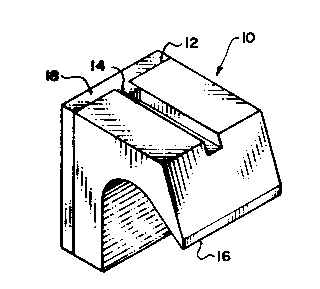Une partie des informations de ce site Web a été fournie par des sources externes. Le gouvernement du Canada n'assume aucune responsabilité concernant la précision, l'actualité ou la fiabilité des informations fournies par les sources externes. Les utilisateurs qui désirent employer cette information devraient consulter directement la source des informations. Le contenu fourni par les sources externes n'est pas assujetti aux exigences sur les langues officielles, la protection des renseignements personnels et l'accessibilité.
L'apparition de différences dans le texte et l'image des Revendications et de l'Abrégé dépend du moment auquel le document est publié. Les textes des Revendications et de l'Abrégé sont affichés :
| (12) Demande de brevet: | (11) CA 2192756 |
|---|---|
| (54) Titre français: | OUTIL POUR L'ENLEVEMENT DU METAL BLANC D'UN COUTEAU DE COUPEUSE |
| (54) Titre anglais: | CHIPPER KNIFE BABBITT REMOVAL TOOL |
| Statut: | Réputée abandonnée et au-delà du délai pour le rétablissement - en attente de la réponse à l’avis de communication rejetée |
| (51) Classification internationale des brevets (CIB): |
|
|---|---|
| (72) Inventeurs : |
|
| (73) Titulaires : |
|
| (71) Demandeurs : |
|
| (74) Agent: | ADE & COMPANY |
| (74) Co-agent: | |
| (45) Délivré: | |
| (22) Date de dépôt: | 1996-12-12 |
| (41) Mise à la disponibilité du public: | 1998-06-12 |
| Licence disponible: | S.O. |
| Cédé au domaine public: | S.O. |
| (25) Langue des documents déposés: | Anglais |
| Traité de coopération en matière de brevets (PCT): | Non |
|---|
| (30) Données de priorité de la demande: | S.O. |
|---|
Outil servant à retirer un bloc d'alliage blanc de l'arrière d'un couteau de déchiquetage semblable à ceux qui sont utilisés pour mettre en copeaux du bois de résineux aux fins de transformation ultérieure. L'outil comporte une base verticale ayant une rainure sur sa face avant et un élément servant à maintenir le couteau dans la rainure lorsque le bloc d'alliage blanc se trouve à l'arrière du couteau. Une lame est forcée le long de la rainure au moyen d'un cylindre pneumatique de manière à heurter l'alliage blanc et à le déloger de l'arrière du couteau. Un récipient placé au fond de la rainure sert à recueillir l'alliage blanc ainsi délogé.
-8-
A tool is used for removing a block of babbitt material from the
back of a chipper knife such as those used in chipping softwood for further
processing. The tool has a vertical base with a channel along its front face anda knife support for supporting the knife in the channel with the block of babbitt
metal at the back. A blade is driven along the channel using a pneumatic
cylinder to impact on the babbitt metal and dislodge it from the knife. A
container at the bottom of the channel collects the dislodged babbitt metal.
Note : Les revendications sont présentées dans la langue officielle dans laquelle elles ont été soumises.
Note : Les descriptions sont présentées dans la langue officielle dans laquelle elles ont été soumises.

2024-08-01 : Dans le cadre de la transition vers les Brevets de nouvelle génération (BNG), la base de données sur les brevets canadiens (BDBC) contient désormais un Historique d'événement plus détaillé, qui reproduit le Journal des événements de notre nouvelle solution interne.
Veuillez noter que les événements débutant par « Inactive : » se réfèrent à des événements qui ne sont plus utilisés dans notre nouvelle solution interne.
Pour une meilleure compréhension de l'état de la demande ou brevet qui figure sur cette page, la rubrique Mise en garde , et les descriptions de Brevet , Historique d'événement , Taxes périodiques et Historique des paiements devraient être consultées.
| Description | Date |
|---|---|
| Le délai pour l'annulation est expiré | 1999-12-13 |
| Demande non rétablie avant l'échéance | 1999-12-13 |
| Réputée abandonnée - omission de répondre à un avis sur les taxes pour le maintien en état | 1998-12-14 |
| Demande publiée (accessible au public) | 1998-06-12 |
| Date d'abandonnement | Raison | Date de rétablissement |
|---|---|---|
| 1998-12-14 |
Les titulaires actuels et antérieures au dossier sont affichés en ordre alphabétique.
| Titulaires actuels au dossier |
|---|
| FERNAND LACOSTE |
| Titulaires antérieures au dossier |
|---|
| S.O. |